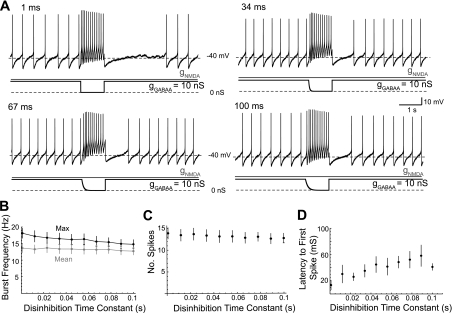Fig. 5.
Burst frequency decreases as the time constant of disinhibition increases. A: concurrent NMDA and GABAA conductance ramps (3:1 ratio) were applied to a dopaminergic neuron in a representative example (as in Fig. 1). A total conductance of 40 nS (gNMDA = 30 nS; gGABAA = 10 nS) was achieved at the end of the ramp and maintained. In 1-s intervals, gGABAA was removed according to a simple exponential decay, 10*e(−t/τd). The disinhibition time constant (τd) was varied. B: unlike mean burst frequency (P > 0.05, n = 8), the maximum burst frequency showed a significantly nonzero slope across the range of τd values (P < 0.05, n = 8). C: the total number of spikes in the disinhibition window was not changed with different τd values (P < 0.05, n = 8). D: the latency to the initiation of the burst, defined as an ISI <80 ms, increased significantly with τd values (P < 0.05, n = 8).

